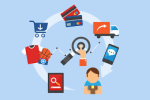A well-structured site navigation is key to improving user experience and boosting conversions. If visitors struggle to find what they need, they’ll leave, increasing your bounce rate and hurting your SEO. A clear, intuitive navigation structure keeps users engaged, guides them to the right pages, and increases the chances of sales. Let’s dive into the best ways to optimize your website navigation for higher conversion rates.
Why Navigation Matters for Conversions
Your website navigation directly impacts customer behavior. A confusing menu leads to frustration, while an optimized layout encourages users to explore and make a purchase. Clear navigation also improves SEO rankings, helping more people discover your site.
Best Practices for Optimizing Site Navigation
- Keep it Simple and Clear – A cluttered menu confuses visitors. Stick to essential categories and use easy-to-understand labels like “Shop,” “About Us,” and “Contact.”
- Use a Sticky Header – A sticky menu remains visible as users scroll, making navigation easier. This feature is especially useful on mobile devices.
- Optimize for Mobile Users – Ensure your menu is responsive, collapsible, and easy to use on smartphones and tablets. Mobile-friendly navigation is crucial for increasing mobile conversions.
- Use Breadcrumbs for Easy Navigation – Breadcrumbs show users their location on your site, reducing confusion and improving user experience.
- Prioritize Important Pages – Highlight key pages like best-selling products, new arrivals, and sales pages to drive engagement.
- Enhance Search Functionality – A well-designed search bar with auto-suggestions helps users find products faster, reducing frustration and improving sales.
- Use Internal Links for Better User Flow – Guide visitors with relevant internal links to related products or informative blogs like How to Optimize Product Pages for Better Sales.
- Add Visual Cues – Icons, drop-down menus, and hover effects make navigation more interactive and engaging.
- Test and Improve Regularly – Use tools like Google Analytics, Hotjar, or A/B testing to track user behavior and refine your navigation structure.
How Internal Links Boost Navigation & SEO
Internal links play a huge role in navigation and SEO. They guide users to relevant pages and help search engines understand your site structure. Check out our guide on SEO Strategies for Shopify Stores to further improve your site’s visibility.
Call to Action – Improve Your Navigation Today!
Your site navigation can make or break your conversion rates. Don’t let a poor layout cost you sales. Optimize your menu, simplify your categories, and guide your visitors effectively. Need expert help? Social Media Max specializes in website optimization and SEO strategies. Contact us now at 0161 399 3517 or email Syed_66@hotmail.com to improve your site and increase your sales today! 🚀

